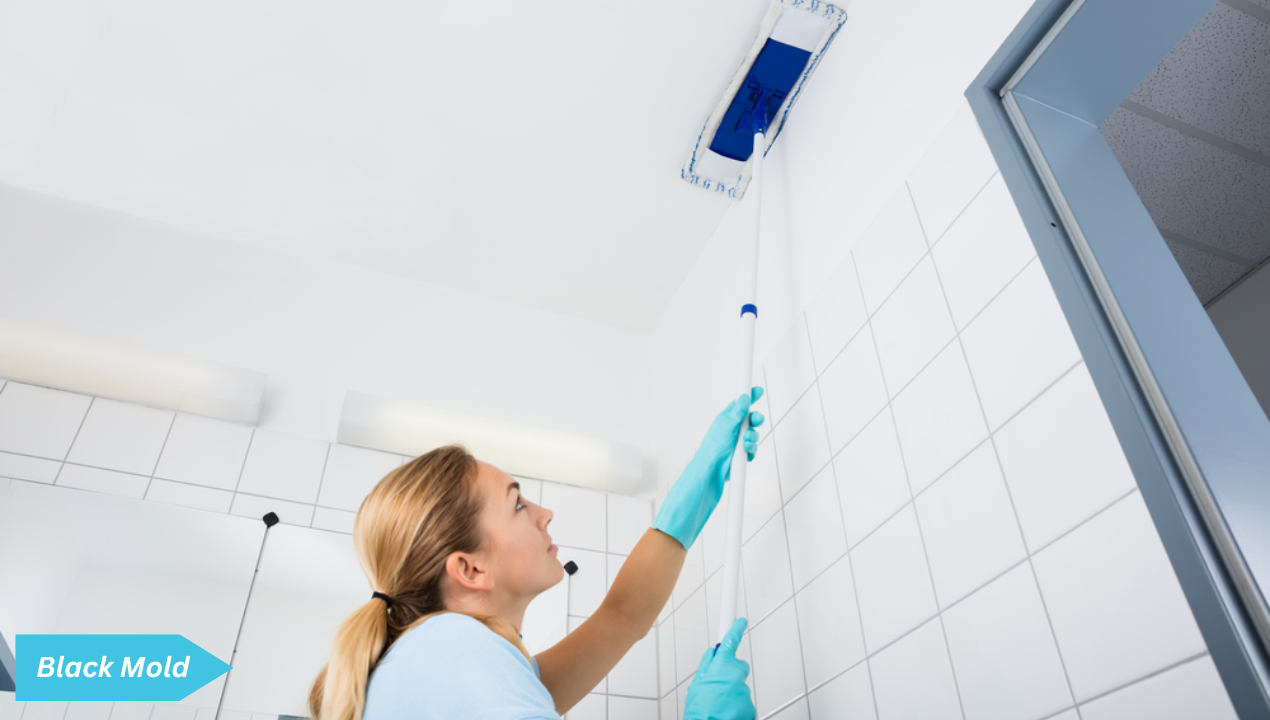You ever stepped into your bathroom and noticed unsightly black spots on the ceiling. Mold isn’t just an eyesore; it poses serious health risks, especially for those with allergies or respiratory issues.
So, let’s check into how you can banish mold from your bathroom ceiling and keep it from coming back.
Causes of Mold in the Bathroom
Why does mold love your bathroom so much? The main reason is moisture. Bathrooms are often damp places, thanks to hot showers, baths, and even sinks. Add in poor ventilation—like an old or non-existent exhaust fan—and you’ve got a recipe for mold growth.
Leaky pipes and fixtures can also contribute by providing a constant source of water for mold to thrive on.
Preparing for Mold Removal
Ready to tackle that mold? Start by gathering your supplies. You’ll need gloves, goggles, a mask, cleaning solutions, a scrub brush, and old towels or rags. Safety is crucial—mold can be harmful, so make sure to protect yourself.
Also, take steps to protect the rest of your bathroom. Cover any fixtures or areas you don’t want to get mold on with plastic sheeting or old towels.
Natural Mold Removal Solutions
If you prefer natural solutions, you’re in luck. Vinegar is a powerful mold killer—just spray it undiluted on the moldy area and let it sit for an hour before scrubbing. Baking soda is another effective option; mix it with water to create a paste, apply it to the mold, and scrub away.
Tea tree oil, although more expensive, is also a great natural fungicide. Mix a teaspoon with water in a spray bottle, apply it to the mold, and let it sit before wiping clean.
Chemical Mold Removal Solutions
For tougher mold, you might need stronger chemicals. Commercial mold removers are readily available and specifically formulated to kill mold. Bleach is another common solution—mix one part bleach to ten parts water, apply it to the mold, and let it sit for a few minutes before scrubbing.
Hydrogen peroxide is less harsh than bleach but still effective; spray it on the mold, let it sit for ten minutes, and then scrub.
Step-by-Step Mold Removal Process
Now, let’s get down to the nitty-gritty of removing mold:
Step 1: Identify and isolate the moldy area. Use plastic sheeting or old towels to cover surrounding areas and prevent the spread of mold spores.
Step 2: Apply your chosen mold removal solution. Whether it’s vinegar, bleach, or a commercial product, spray or apply it generously to the moldy spots.
Step 3: Scrub the mold away. Use a stiff brush to scrub the mold off the ceiling. Be thorough—mold can be stubborn.
Step 4: Rinse and dry the area. Use clean water to rinse off any remaining cleaning solution, then dry the area completely. Mold loves moisture, so ensuring the area is dry is crucial to prevent regrowth.
Preventing Mold Regrowth
You’ve removed the mold, but how do you keep it from coming back? Improving ventilation is key. Make sure your bathroom fan is working properly and consider leaving it on for a while after showers to help reduce humidity. Using a dehumidifier can also help keep moisture levels in check.
Finally, establish a regular cleaning routine. Wipe down your bathroom surfaces regularly to keep mold at bay.
When to Call a Professional
Sometimes, mold problems can be too big to handle on your own. If the mold covers a large area, is in hard-to-reach places, or if you have health concerns, it’s best to call in a professional. They have the tools and expertise to handle severe infestations safely and effectively.
DIY vs. Professional Mold Removal
Should you tackle mold removal yourself or hire a pro? DIY mold removal can be effective for small infestations and is certainly cheaper. However, professionals can handle larger or more serious mold problems and ensure thorough removal. Weigh the pros and cons of each option before making your decision.
Cost of Mold Removal
What will this all cost you? DIY mold removal supplies are relatively inexpensive—you might spend $20 to $50 on cleaning solutions and protective gear. Professional services, on the other hand, can range from $500 to $6,000, depending on the extent of the mold problem.
Maintaining a Mold-Free Bathroom
Keeping your bathroom mold-free requires ongoing effort. Develop daily habits like wiping down surfaces and ensuring proper ventilation. Regular maintenance, such as checking for leaks and promptly addressing any moisture issues, will also help keep mold at bay.
Conclusion
Mold on your bathroom ceiling is more than just an aesthetic issue—it’s a health hazard. By understanding what causes mold, recognizing the signs, and following a thorough removal process, you can keep your bathroom mold-free. Remember, prevention is key. Keep your bathroom dry, ventilated, and clean to stop mold from returning.
